Crape Myrtles are beloved in Southern gardens and cityscapes for their endless summer blooms and classic silhouettes. Meanwhile, West Coast gardeners swear by the plant’s landscape versatility, too.
- After a full summer of color, Crape Myrtle’s fall foliage glows in radiant shades of red, orange, and yellow. Plant in a landscape where you can enjoy them backlit by early morning or late afternoon light.
- Winter reveals a Crape Myrtle’s sculptural trunks and branches. Some are lustrous and smooth. Some peel back to reveal layers of mottled color. There is nothing quite like them in their spicy shades of nutmeg, buff, ginger tan, gray, and cinnamon.
- In spring, many varieties put on bold, contrasting new growth atop mature, green-leaved branches. Others grow with nearly black foliage that grounds the landscape in an otherwise boisterous burst of spring.
Take a look at some of our favorite Crape Myrtle trees below. Remember that fall is the perfect time to plant trees like Crape Myrtles. It gives the roots all winter to grow, allowing the tree to emerge strong and healthy in the spring.
GET THE LOOK: This Northwest or Pacific Northwest garden plays Crape Myrtle bark off European Ostrich Fern (shown). We love this contrast in texture, especially in winter’s cooler light.
PHOTOS: Doreen Wynja unless otherwise noted
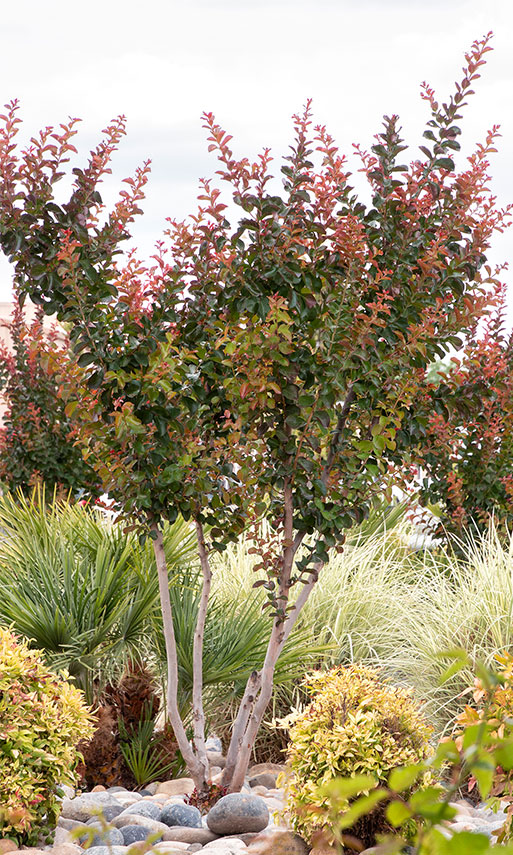
GROW THIS LOOK: Dynamite® Crape Myrtle and Morning Light Maiden Grass shine in your spring border.
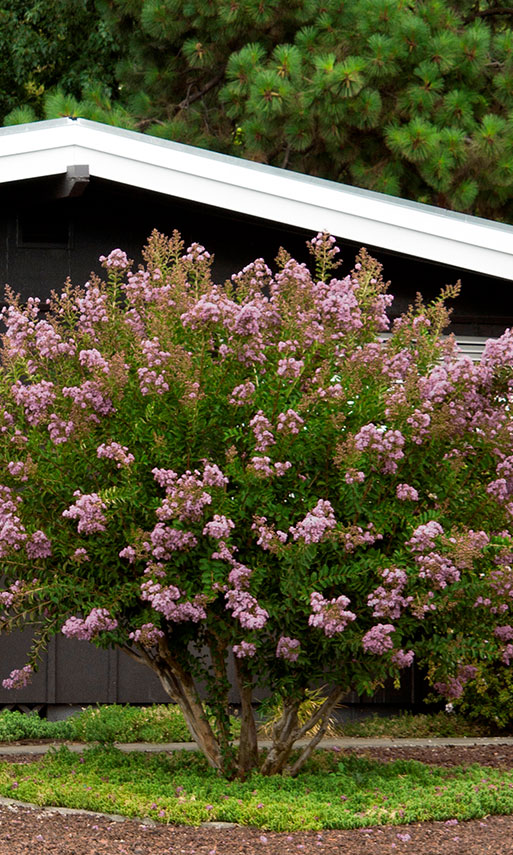
GROW THIS LOOK: Muskogee Crape Myrtle has high impact blooms in summer and beautiful bare branches in winter.
How to design a garden with Crape Myrtle
As with every plant for your landscape, you want to start with the right plant for the right place.
- Crape Myrtles deserve a space where they get four-season attention. Plant your favorite flower or foliage color as a statement tree. Indulge in a showstopping hedge or line your sunny driveway with an informal allée. Many varieties also do well in containers, bringing all that beauty up close on your year-round patio or deck.
- Choose a location that allows your Crape Myrtle to reach maturity, without crowding. Crape Myrtles are as small as 3’ – 4’ shrubs and as large as 15’- 20’+ trees, so read (and heed) your plant descriptions carefully.
- Choose one of our varieties for their exceptional mildew and pest resistance. We grow our Crape Myrtles in a plant-perfect soil blend we’ve customized specifically for the plant. Rich with mycorrhizae, slow-release fertilizer, and other beneficial ingredients. Your Monrovia Crape Myrtle will get the best possible start in your landscape.
Underplanting ideas for Crape Myrtles
Small Crape Myrtle trees take on extra grandeur when you underplant them with the right groundcover. We love…
- Flower Carpet® Groundcover Rose (Zone 4 – 10)
- Silvery Sunproof Lilyturf (Zone 6 – 11)
- Coral Beauty Cotoneaster (Zone 5 – 10)
Low-growing azaleas and semi-transparent grasses can also be beautiful under your Crape Myrtles.
Grow red flowering Crape Myrte
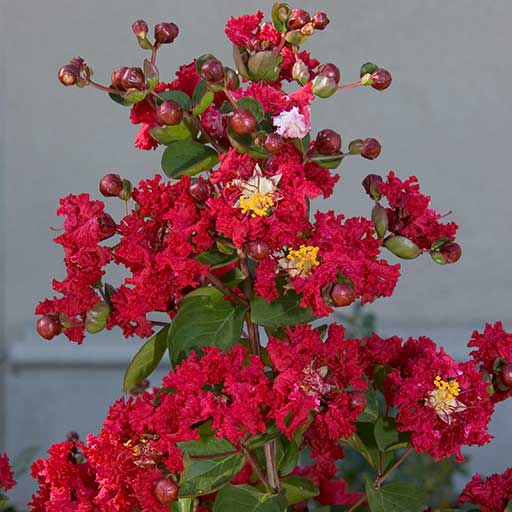
Large, long-lasting clusters of rose-red, crepe-like flowers attract late summer butterflies. Color stays true and won’t fade. Mildew-resistant foliage is dark green in summer, then red-orange in fall. Greige colored bark peels back in thin strips to reveal smooth, cream-colored bark.
Plant along both sides of your drive for an incomparable late summer show. Beautiful bark is exceptional up close. Plant for shade near outdoor living spaces. Deciduous.
Lagerstroemia indica ‘Centennial Spirit’
Reaches 10’ – 20’ tall and wide
Full sun
Zone 7 – 9
Photo: Richard Schiell
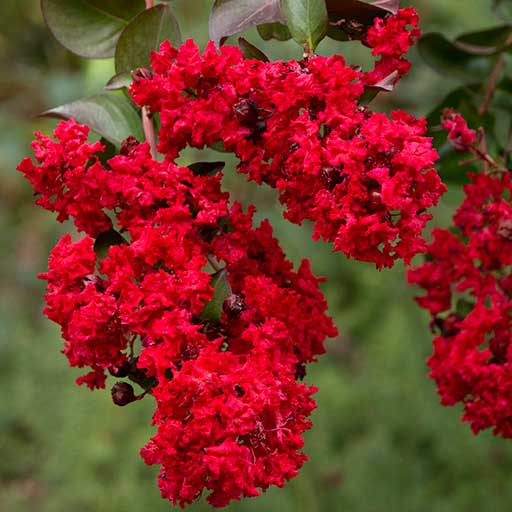
New spring leaves emerge red and shift to vibrant green. Summer flowers are showy, ruffled, fiery, and true red. Butterflies love them. Come fall, foliage glows in vibrant orange-red tones. In winter, the beautiful trunks and branches with smooth, peeling bark come into their own.
Extremely mildew resistant and drought tolerant. Excellent as a specimen plant or en masse for an explosion of color in the landscape and year-round interest. Deciduous.
Lagerstroemia indica ‘Whit II’
Reaches 15’ – 20’ tall, 10’ – 15’ wide
Full sun
Zone 6 – 10
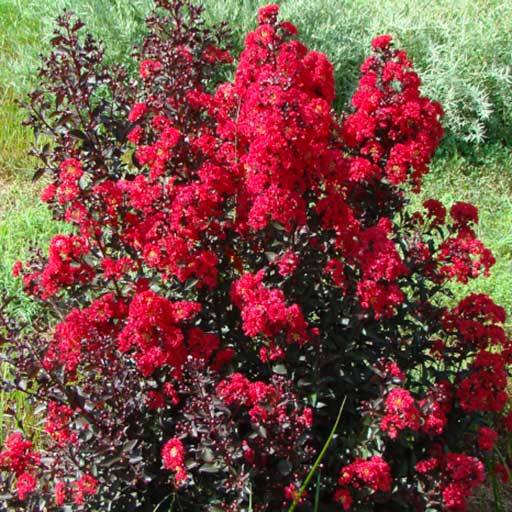
This reblooming crape myrtle warms up with colorful, deep purple foliage that matures to a dark purple-green. The intensely cherry red flowers cluster across its rounded, upright form. Resists mildew and leaf spot well. Heat tolerant.
NOTE: Double Dynamite does not exhibit exfoliating bark typical of its species. (You may find it does as it matures.) Gardeners frequently agree, its reblooming habit is a fair trade-off.
Lagerstroemia indica ‘WHIT X’
8’ – 10’ tall, 8’ – 12’ wide
Full sun
Zone 7 – 10
Photo: Lacebark
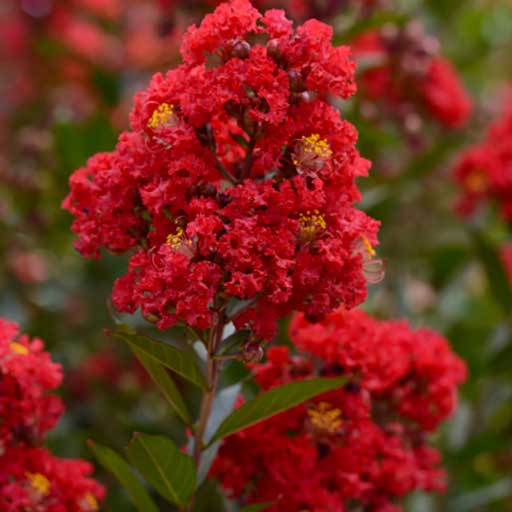
Early flowering and reblooming, showstopping scarlet red flower clusters will delight you and the butterflies all summer long. An upright, mid-size variety, glossy foliage emerges red then matures to a dark green. Perfectly sized for containers or tight spots in your landscape.
Introduced by renowned horticulturist Michael A. Dirr. Excellent powdery mildew and leaf spot resistance. Produces small berries in midsummer. Foliage turns a rich red color in fall. Deciduous.
Lagerstroemia ‘PIILAG B5’
Reaches 4’ – 5’ tall and wide
Full sun
Zone 6 – 10
Photo: Ball
Grow pink, purple, and white flowering Crape Myrtle
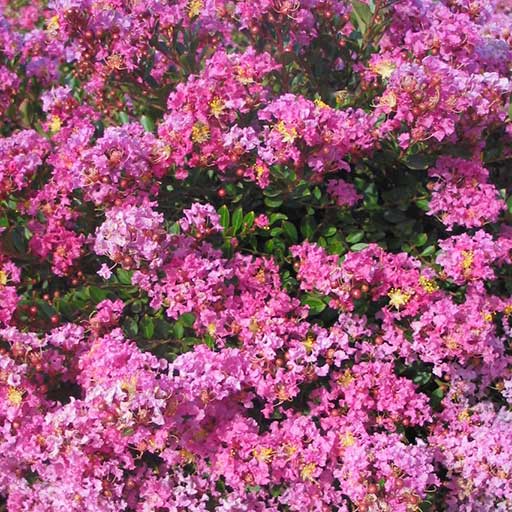
Large clear pink flower clusters bloom a bit later, from mid-summer through fall. Excellent mildew resistance on glossy dark green foliage that glows with rich orange, red, and maroon fall color. Graceful, gently curving branches bare beautiful, multicolored, exfoliating bark.
More spreading than upright in habit. Enjoy sinewy, fluted stems that can grow into a low canopy in small space gardens. Deciduous.
Lagerstroemia indica x fauriei ‘Pecos’
Reaches 8’ tall, 6’ wide
Full sun
Zone 6 – 9
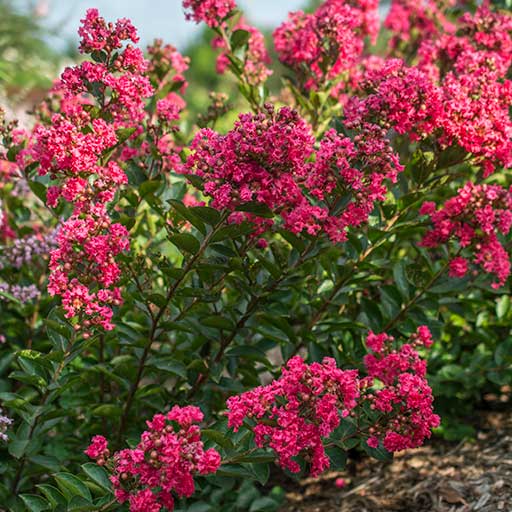
Not a tree, but a breakthrough, compact shrub with dense stems. The lovely bark peels away revealing multiple shades of tan, cream, brown, and greige. Nonstop, deep raspberry-pink blooms earlier than other varieties and won’t quit till early fall. Foliage turns bold red-orange in autumn.
The low, mounded form is excellent for foundation plantings. Use in mixed shrub borders or as a low hedge, too.
Lagerstroemia indica ‘Conlagras’
Reaches 3’ – 4’ tall and wide
Full sun
Zone 5 – 9
Prefer purple to pink? Grow Bellini® Grape Crape Myrtle.
Photo: Star Roses & Plants
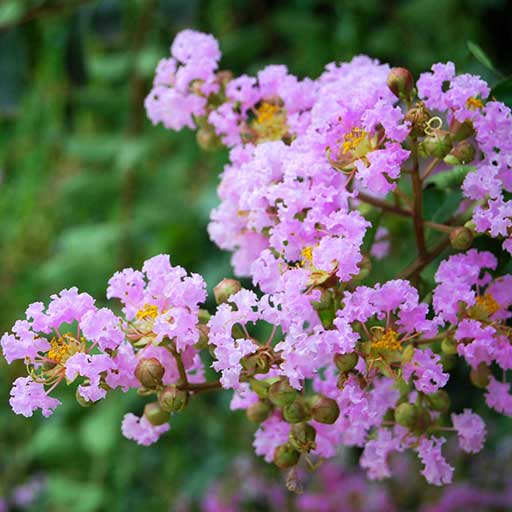
Panicles of light lavender-pink flowers appear amid glossy green foliage that turns engine red in fall. Smooth, cinnamon colored bark peels back to reveal shiny, lovely light gray mottling. Grow as a large shrub or hedgerow for summer privacy. You and your pollinators will love its summer-long color.
With a spreading, opening habit, Muskogee is an excellent specimen or en masse. Deciduous.
Lagerstroemia indica x fauriei ‘Muskogee’
Reaches 15’ – 20’ tall, 15’ wide
Full sun
Zone 6 – 9
Love dark purple, too? Grow Catawba Crape Myrtle.
Photo: Li Xuejun
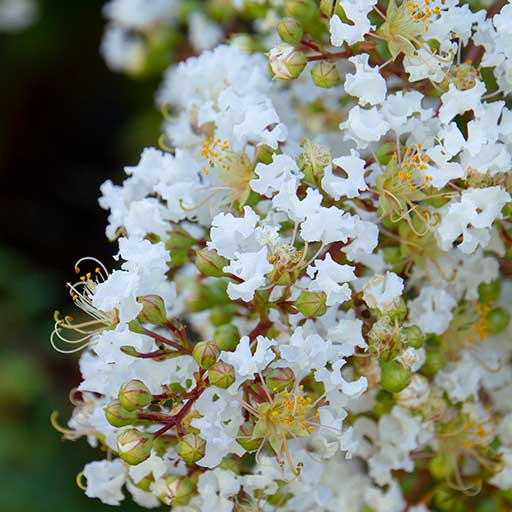
Grow as a large shrub or small tree with cloud-like panicles of soft, pure white blooms all summer. Glossy dark green leaves turn vibrant orangey-red in fall. Smooth, dark and cinnamon brown bark is sculptural and exfoliating, with exceptional beauty on bare winter branches.
Bird-friendly and waterwise like all Crape Myrtle. Grow Natchez against a dark or evergreen background for extra summer drama.
Lagerstroemia indica x fauriei ‘Natchez’
Reaches 20’ tall and wide
Full sun
Zone 6 – 9
Is it “Crape Myrtle” or “Crepe Myrtle?”
It’s both. For instance, Southern Living stands by the French spelling of “Crepe.” This makes sense since the common name references the flowers’ “crepe” papery appearance.
However, we subscribe to “Crape Myrtle.” This spelling is also preferred by the Crape Myrtle Society of America and the USDA. As well as the Royal Horticultural Society and the great Dirr’s Encyclopedia of Trees and Shrubs (Indiebound; Amazon).




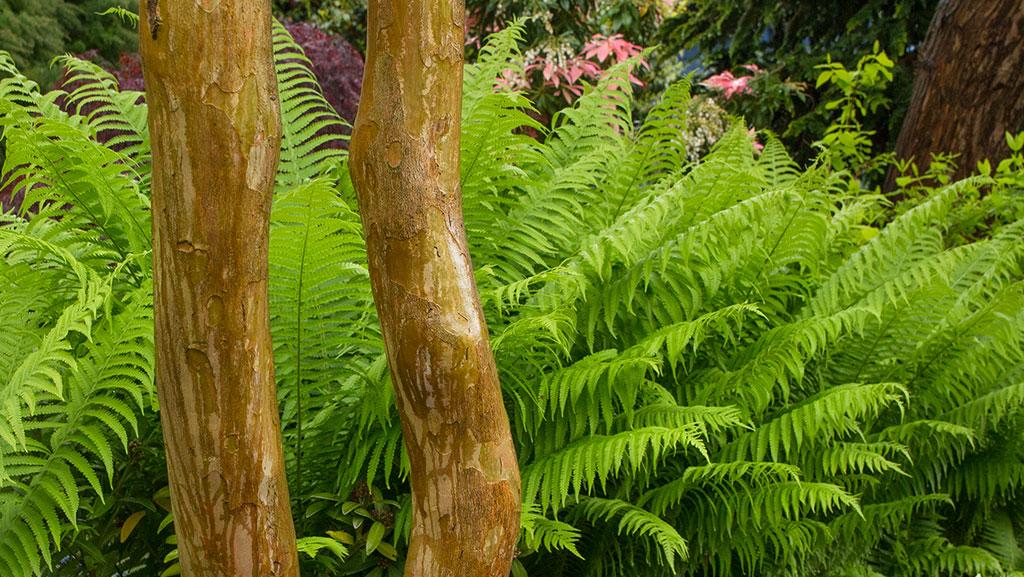
Please login to comment.
Don't have an account?
Sign Up for free